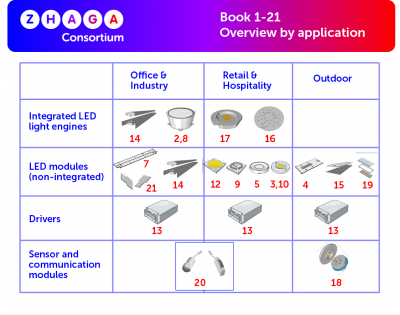The Zhaga interface standard for street lighting future-proves luminaires to keep pace with rapid developments in digital technology. It enables a multi-vendor eco-system of interoperable luminaires and sensor/communication modules and breaks existing barriers to smart and connected lighting.
The Zhaga smart interface specifications will have a major impact on the value of the lighting infrastructure for connectivity and on the investment decisions of city governments, specifiers and utility companies. It will drive innovation in in sensor/communication modules incorporating new smart applications.
Zhaga is an open and global consortium of lighting companies that creates interface standards for components of LED luminaires. Zhaga so enables multi-vendor eco-systems of interoperable products.
Zhaga has now applied its vision to connectivity and smart streetlighting. The standard in the Zhaga Book 18 was published in November 2019 and is called “Smart interface between outdoor luminaires and sensing / communication modules”. This standard defines a smart luminaire interface, including mechanical socket and communication and control aspects, so that a sensor/communication module can be externally mounted on the luminaire supported by plug-and-play. The interface is in this respect similar to the USB slot on a computer.
This short paper describes the vision leading to the standard, the standard itself, certification aspects, and ends with a brief conclusion.
Connectivity vision
The increasing digitisation in many areas of our society presents new challenges to manufacturers, specifiers, installers and users of lighting installations. The long lifetime of outdoor lighting is very difficult to match with the dynamic developments in digital technology.
This inability to combine the long-lasting nature of the lighting infrastructure and the rapid changes in digital communication and sensor technology has led to an underutilization of the lighting infrastructure for smart applications and has regrettably reduced the solution toolbox for smart city and smart buildings. This has hampered progress in this space.
To resolve the challenge and secure a central place for lighting in smart city, a connectivity solution for lighting should at least meet the following requirements. From a functional point of view, the solution should enable the lighting to connect to the IoT, enable light management through control and energy and status reporting, and support beyond lighting applications.
From a more methodological point of view, the solution should be future proof and easily upgradable to keep pace with rapid developments in digital networking technology. It should also be based on standards to avoid vendor lock in.
Zhaga solution
Zhaga has now addressed this problem by creating a new interface standard for outdoor luminaires. This standard turns the streetlighting infrastructure into a strong enabler for smart cities.
The Zhaga standard for smart streetlighting defines a smart luminaire interface which includes both a mechanical socket and communication and power aspects. It allows a sensor/communication module to be externally mounted on the luminaire and supports plug-and-play. The interface is in this respect similar to the USB slot on a computer.
Luminaires with the Zhaga interface can be equipped – in field – with sensor/communication modules to extend their initial functionality. In one case, the module includes radio communication, and enables remote light control and the transmission of diagnosis and energy data to a central management system. In another case, the module includes sensors. In yet another case, the module includes even more advanced smart city applications for e.g. city security of environmental control.
Certification
The Zhaga vision on connectivity hinges on the interoperability between luminaires and sensor/communication modules of multiple vendors.
To create trust in interoperability, Zhaga has defined a certification program to accompany its standards. The program is carried out by independent test houses and the certification status of products can be verified though a publicly accessible database and though logos which are trademarked to prevent misuse.
The logo also presents business advantages to end-users, as it encourages a wide supply of innovative solutions and multi-vendor sourcing options. For manufacturers, the certification logo offers a strong marketing tool, and shows that the product derives added value from a strong product eco-system.
Conclusion
The Zhaga interface future-proves a luminaire and ensures that it can keep pace with rapid developments in digital networking, sensing and smart-city technology. Modules incorporate the developments and are easily replaced. An installed base of luminaire with the Zhaga interface drives innovation in the module market; innovations in the module market add value to the lighting infrastructure. A certification and logo program create further trust in the interoperability of luminaires and nodes from different vendors.
The Zhaga smart interface standard for streetlighting, the Zhaga Book 18 was published in November 2019. First certified products and infrastructure installations are now available. Zhaga will shortly publish a standard for indoor lighting, based on an approach comparable to the one used for outdoor.
For further information please visit: www.zhagastandard.org







Recent Comments